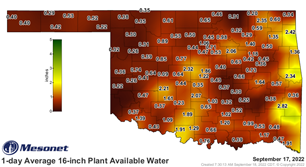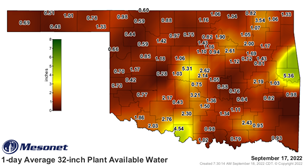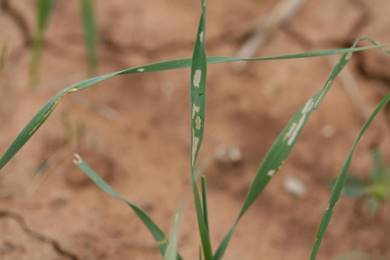Cow-Calf Corner | September 19, 2022
Wheat Grazing Prospects Dim
Derrell S. Peel, Oklahoma State University Extension Livestock Marketing Specialist
Most years, September would be occupied by lots of attention to wheat planting and budgets for winter grazing of stockers. However, the latest Drought Monitor shows that 99.97 percent of Oklahoma is abnormally dry or worse (D0-D4) with 48.81 percent in D3 and D4 (Extreme or Exceptional Drought). The three maps below from the Mesonet system show plant available water at 4-inch, 16-inch and 32-inch depths. The dark red and brown colors of the maps indicate that the soil profile of much of the state is very dry from top to bottom.



The USDA Crop Progress report for September 13 showed that 11 percent of Oklahoma wheat was planted, ahead of the five-year average of four percent for that date. I traveled across much of western Oklahoma last week and did see several planted fields and even a couple with wheat emerged. In many cases the wheat is being “dusted in”, planted in dry soil, hoping that rain will be forthcoming to germinate the wheat. Whether wheat is planted with enough moisture to germinate or is waiting for rain to emerge, the dry soil profile means that additional timely rains will be needed to sustain a wheat stand. The forecast for the next week or more is for unseasonably (maybe record!) warm temperatures with little chance of precipitation. Wheat grazing prospects look dim and risky this fall.
The widespread drought conditions mean that I have received far less than the usual number of questions about the economic prospects for winter stockers this year. Nevertheless, there may be some grazing opportunities in some places. Stocker budgets are driven by the overall level of cattle prices and the relationship between purchase prices for lightweight stockers and the expected price of heavy feeder cattle later. The difference in the purchase price and selling price of stocker cattle is the rollback that determines the gross value of gain for adding weight to feeder cattle. The stocker price rollback is the mirror image of the cost of gain for feedlots because feeder markets reflect whether it is cheaper to put weight on feeder cattle in forage-based stocker programs before they arrive at the feedlot or with grain-based rations after placement in the feedlot. Southern plains feedlot cost of gain for steers is roughly $1.25 - $1.30/lb. currently, so stocker value of gain will typically be about that same level. For example, using current Oklahoma feeder prices, the value of 300 pounds of gain on a 475-pound steer is $1.29/lb. Moreover, for stockers that will be marketed after winter grazing, there is currently about a $7.00/cwt. increase in Feeder Futures prices between the nearby and March contracts which adds even more to the value of gain. In other words, if winter stocker grazing is possible, the budgets look attractive at this time.
Benefits of Early Culling Open Breeding Heifers
Mark Z. Johnson, Oklahoma State University Extension Beef Cattle Breeding Specialist
Early culling of open breeding heifers has several benefits to your cow-calf operations bottomline. Pregnancy can be diagnosed by palpation at 60 days and by ultrasound as early as 30 days, so now is the now is the time to take action and cull the open heifers. In addition to reducing grazing pressure on drought stressed pastures there are several other long-term benefits. Typically we should expect well developed yearling heifers, at 65% of their mature weight, going into their first breeding season to conceive in a fairly short (45- 60 days) breeding season. The easiest time in a beef breeding females life to get bred, should be as a well-developed yearling heifer. Because of this, culling open heifers as soon as possible leads to:
- Improving the long-term reproductive performance of your cow-herd. Reproductive traits are low in heritability; nevertheless, culling open heifers will improve the genetic potential for reproductive performance in your cow-herd by eliminating the sub-fertile heifers. From business standpoint, reproductive success (percent calf crop weaned) is of critical economic importance in the cow-calf sector.
- Culling open yearling heifers right now still gives them the potential to be marketed as yearlings. At this age they still have the potential to finish out while in the A maturity group and harvest as fed cattle reaching the most valuable Quality Grades (Choice and Prime).
It is a best management practice to breed heifers to calve a little ahead of our mature
cow herd. It permits us to concentrate our management efforts during the heifer’s
calving season and, as importantly, to give them a little extra time to breed back
and calve on schedule the following year. With this in mind, hold your replacement
heifers accountable and cull opens as soon as practical to save on feed bills, capture
their maximum value and improve the fertility of your cow herd.
Be Sure to Check Early Planted Wheat Fields for Fall Armyworms
Paul Beck, Oklahoma State University Extension Beef Nutrition Specialist
In my weekly trips to western Oklahoma, I have noticed that areas have received enough rainfall to start planting wheat. Several fields look to have been planted early and have very nice stands, while planting in areas with good moisture is progressing rapidly. It appears that some of our focus has shifted away from maximum grain production to earlier planting to enhance wheat forage production due to our poor range conditions and short hay crop.
Fall armyworms are a big concern because we have at least 6 weeks before our first killing frost. This is time to allow for at least two generations of moth flights for laying eggs. Fall armyworms affect sorghum and corn, so they can act as bridge crops for armyworms that can affect our early planted fall wheat fields, there may be multiple generations of armyworm larva. Early planted wheat grows slowly due to the warmer temperatures and armyworm larva can keep up with the wheat growth causing major damage.
Armyworm moths can lay 1,000 eggs, which can hatch in 3 to 10 days. The caterpillars molt 6 times over 21 to 28 days increasing in size with each molt, or ‘instar’ stage. Mature fall armyworms are green to brown and are 1.5 inches long with an inverted Y on their head.
It is important to scout fields and detect armyworm larva at early stages or ‘instars’. Early instars are more susceptible to insecticide products and they do not cause as much damage. Armyworms are very hard to see until they reach instar 4 or 5, but they consume 94% of their lifetime forage intake during their last 5 to 6 days during instars 5 and 6. Mature larva are voracious feeders and can consume a field in just a few days. Smaller larva do not eat through the leaf but consume the green tissue in a leaf, leaving a clear membrane that looks like a window pane.

Scout at least 5 to 10 locations in the interior of each field. Treatment should occur when there are 2 to 4 caterpillars in a linear foot of a row with feeding damage present.
For detailed treatment guidelines consult OSU Factsheet CR7193 Management of Insect Pests in Rangeland and Pasture and CR7194 Management of Insect and Mite Pests in Small Grains
5 States Beef Conference Focuses on Range Management During a Drought
Britt Hicks, OSU Panhandle Area Extension Livestock Specialist
The Annual 5-State Beef Conference is being held in Beaver, OK on Tuesday, October 4 at the Beaver County Fair Building (10:00 AM - 4:00 PM). The conference will focus on range management during a drought. Our keynote speaker this year is Kit Pharo with Pharo Cattle Company.
The program follows:
- Ranching Made Profita-BULL, Enjoya-BULL and Sustaina-BULL, Part 1; Kit Pharo, Pharo Cattle Company, Cheyenne Wells, CO
- Strategic Level Actions and Monitoring Grazing Adaptively in a Drought Prone World; Dr. Tim Steffens, Texas A&M AgriLife Extension Service
- What is Stewardship? (Drought Adjustment, Economic & Ecological Stewardship, and Relationships); Justin Rader, Rancher, Canadian, TX
- Current and Future Drought Decision Making: Specific Actions that have Proven Successful in Managing Grazing and Adapting to Drought Conditions; Adam Isaacs, Rancher, Canadian, TX
- Panel Discussion
- Drought Insurance; Jennifer Ifft and Cordon Rowley, Kansas State University
- Ranching Made Profita-BULL, Enjoya-BULL and Sustaina-BULL, Part 2; Kit Pharo
Dinner and proceedings will be provided. The registration deadline is Thursday, September 29. There is a $20 registration fee for the conference.
For more information about registration: please contact Loren Sizelove (Beaver County), 580-625-3464; Britt Hicks (OSU Area Livestock Specialist), 580-338-7300; Scott Strawn (Ochiltree County, TX), 806-435-4501; or JR Sprague (Lipscomb County, TX), 806-862-4601.
